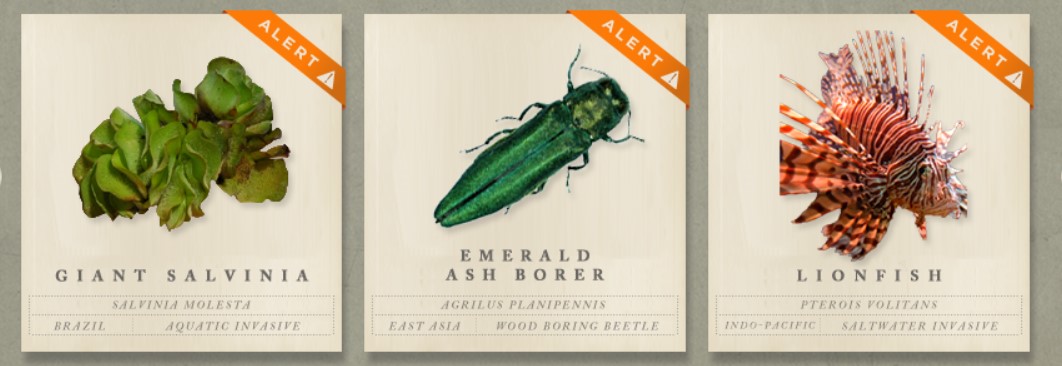National Invasive Species Awareness Week Feb. 28 – Mar. 4 Encourages Action to Combat Harmful, Non-Native Plants and Wildlife
AUSTIN – During National Invasive Species Awareness Week (NISAW), Feb. 28 – Mar. 4 this year, the Texas Parks and Wildlife Department (TPWD) asks Texans to help slow the spread of invasive species affecting our state’s natural resources and economy. The Office of the Governor has recognized NISAW with an official proclamation.
“Each year, a week is dedicated to raising awareness about the dangers of invasive species,” said Governor Greg Abbott. “At this time, I encourage all Texans to learn more about the steps Texas takes to control populations of invasive species and how all Texans can help prevent their spread. By continuing to be wise stewards of our natural resources, we can ensure a better and brighter future as we build the Texas of tomorrow.”
Invasive species are non-native to an ecosystem and can cause environmental or economic harm to human health and quality of life. In addition, invasive species are expensive to prevent and control. According to recent estimates, they can cause costly damage to crops, fisheries, forests, and more, costing approximately $219 billion across the U.S. Many invasive species are spread inadvertently or intentionally by humans, who play an essential role in preventing their spread.
Various plants, animals, insects, and even diseases can become invasives when they enter a new environment, growing or reproducing rapidly and potentially out-competing native species. It allows them to become established and problematic across large areas. They can be introduced by humans in various ways, including intentional introduction through aquarium dumping or bait releases or accidentally as “hitchhikers” carried through recreational activities. These risky activities can include a long haul of firewood for a campfire or moving a boat from one reservoir to another without adequately cleaning, draining, and drying it first. Once introduced, some species can harm native species and ecosystems, impact recreational activities, damage infrastructure, and require costly, long-term management in cases where control is possible.
This year for NISAW, TPWD offers five easy actions to help prevent or slow the spread of invasive species in Texas.
Never Dump Your Tank
Don’t dump anything, whether it’s fish, animals, or plants, out of an aquarium into any of Texas’ waterbodies. The same is valid for flushing them down the toilet. Whether saltwater or freshwater, there’s a good chance your aquarium fish, animals and plants are not native to Texas. If you dump them into the wild, they can quickly introduce diseases and establish themselves at the expense of native aquatic life, vegetation, and reef systems. Learn more on the Texas Invasives website.
Similarly, you should never release any animal you have purchased as a pet into the wild. Most likely, your pet is not native to Texas and could cause serious harm to our native species and ecosystems. Again, find more resources on the Don’t Let It Loose website.
Only Use Native Gulf Shrimp as Bait
Shrimp is a popular bait choice, but not all shrimp species can be bait because some can introduce diseases. While not harmful to humans when eaten, imported shrimp may carry several known viruses or conditions that can spread to native Gulf shrimp species and other shellfish such as crabs and crawfish, causing considerable harm to saltwater and freshwater environments. Many of these viruses can survive the freezing process and may be present even in imported shrimp sold in the freezer sections of grocery stores.
Never use imported fresh or frozen shrimp in Texas waters. Imported shrimp includes all shrimp species not native to the Gulf of Mexico, including shrimp from other countries like Venezuela, Thailand, or other non-Gulf states like California. Learn more about bait shrimp on the TPWD Fishing with Bait Shrimp website.
Plant Native
When landscaping near your home or planting a garden, you must choose plants native to your region. Non-native plants can escape cultivation and become invasive and impact water quality, biodiversity, fish and wildlife habitats, and more.
Don’t Carry Hitchhikers.
You could be carrying invasive species with you and not even know it. Insects and plants, including plant seeds, can hitch a ride on your clothes, shoes, gear, or even your firewood. You can help stop the spread by removing plants, animals, and mud from clothing, boots, equipment, pets, and vehicles, cleaning your gear before entering and leaving recreation sites, using only local firewood, and simply staying on designated roads and trails. Learn more on the Play, Clean, Go website.
Clean, Drain and Dry Your Boat and Gear
Boaters can help keep zebra mussels, giant Salvinia, and other invasive species from moving and harming more lakes. We ask all boaters to take a few minutes to clean, drain properly, and dry boats and equipment every time they go boating before leaving a lake.
Remove plants, mud, and debris from the boat and trailer, drain all the water from the boat and gear, open up compartments once you get home, and allow everything to dry completely.
For more information on properly cleaning, draining, and drying boats and equipment, visit the TPWD YouTube channel for a short instructional video. If you have stored your boat on the water at a lake with zebra mussels, they may have infested it. Before moving it to another lake, call TPWD at (512) 389-4848 for guidance on decontamination.
Learn more about aquatic invasive species on the Stop Invasives page of the TPWD website.
TPWD also encourages the public to use the Texas Invaders app or website to report sightings of invasive species, be it in your backyard or wild spaces. Citizens can learn how to identify invasive species on the Texas Invasives website.








 EastTexasRadio.com Powered by Ten Stations
EastTexasRadio.com Powered by Ten Stations





